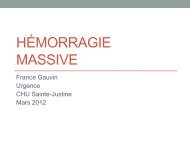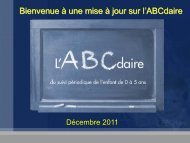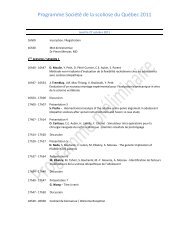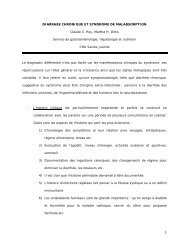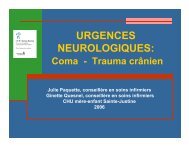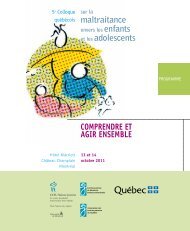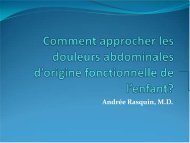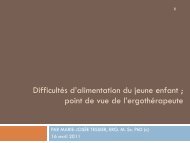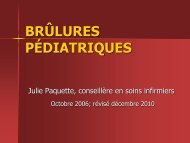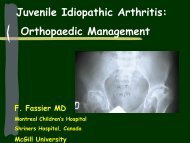Airway Difficile chez l'enfant - CHU Sainte-Justine - SAAC
Airway Difficile chez l'enfant - CHU Sainte-Justine - SAAC
Airway Difficile chez l'enfant - CHU Sainte-Justine - SAAC
Create successful ePaper yourself
Turn your PDF publications into a flip-book with our unique Google optimized e-Paper software.
<strong>Airway</strong> <strong>Difficile</strong> <strong>chez</strong>l’enfantUne proposition de travailMarie-Andrée GirardJosé-Luis MartinezHôpital Ste <strong>Justine</strong>
La prémisse de baseINTERROMPEZ NOUS DÈS QUE VOUS AVEZ UNE QUESTION OU UNCOMMENTAIRE, C’EST L’INTERACTION QUI EST IMPORTANTE!!!
Les articles inspirants cetteprésentation: 1. Weiss M, Engelhardt T. Proposal for the management of theunexpected difficult pediatric airway. Pediatric Anesthesia2010;20:454-464 2. Engelhardt T, Weiss M. A child with a difficult airway: whatdo I do next? Current Opinion Anesthesiology 2012;25:326-332 3. Heinrich S, et Al. Incidence and predictors of difficultlaryngoscopy in 11.219 pediatric anesthesia procedures.Pediatric Anesthesia 2012;22:729-736 4. Sims C,Von Ungern-Sternberg B. The normal and thechallenging pediatric airway. Pediatric Anesthesia2012;22:521-526
Classifier le AW difficile…On vous propose une classification «TEMPORELLE» :
« Vrai » airway difficile:attendu ou connu Concept basique:RÉFÉRER OU CHERCHER DE L’AIDEsaufSituation salvatrice de membres ou de vie Importance de la canule de guedel, des trompettesnasales et du LMA si nécessaire
<strong>Airway</strong> difficile <strong>chez</strong> l’enfant:Une classification <strong>Airway</strong> normal PRÉINTERVENTION mais difficile de façoninattendu Obstruction anatomique Obstruction fonctionnelle <strong>Airway</strong> normal altéré PRÉINTERVENTION Inflammation Corps étranger Allergie Trauma
<strong>Airway</strong> difficile inattendu <strong>chez</strong> lepatient normal Obstruction anatomique/mécaniqueCausesTraitementPosition inadéquate de la têteMauvaise technique masque facialeGrosses adénoïdes ou amygdales, obésitéRepositionner airwayReposition masque/chin lift/jaw thrustCanule nasale/GuedelCorps étrangerContenu gastriqueSangJaw thrust/bouche ouverte/chin lift à deux mains etventilation au masque à deux personnesLaryngoscopie directe –Enlever le corps étrangerIntubation trachéale-recrutement alvéolairedécompressiongastriqueTenter LMA ou autre DVAS si échec à l’intubation
COMMENT éviter de se«peinturer» dans le coin?
Prévention Maintien des compétences enseignement et supervision dedié-pratique fréquente enventilation <strong>chez</strong> le nouveau-nés, et enfants. Profiter descas de courte durée. Évaluation préopératoire Préparation de l’environnement: équipement APPROPRIÉ À L’ÂGE Multiples techniques de préoxygénation SAVOIR OÙ EST LE PLAN A-B-C Travail en ÉQUIPE
Comment optimiser la ventilationau masque? Eliminer/traiter obstruction anatomique Reouvrir airway Canule Guedel/Trompette nasale 2 mains: jaw thrust/chin lift /bouche ouverte –ventilation àdeux (masque facial) Eliminer/traiter obstruction fonctionnelle <strong>Airway</strong> superieur Profondeur anesthésique inadéquate Laryngospasme <strong>Airway</strong> Inférieur Rigidité thoracique Bronchospasme Hyperinflation estomac
Cas clinique:Une « simple »Myringotomie
PréventionCompétence – Évaluation préopératoire – Préparation de l’environnementDéfaut d’OXYGÉNATIONOptimisation de la ventilation au masqueÉliminer / traiter obstruction anatomiqueÉliminer/traiter obstruction fonctionnelleÉCHEC – APPEL À L’AIDE
ÉCHEC – APPEL À L’AIDE / CHARIOT IDContinuer avecla procédure sioxygénation etventilation OKSUCCÈSPLAN ARéaliser une laryngoscopie si SatO2 "Enlever corps étrangerINTUBERÉCHECCONSIDÉRER laprocédure sioxygénation etventilation OKSUCCÈSPLAN BInsérer LMA classique ou LMA pour intubationCHANGER LA TAILLE si ÉCHECREVENIR AU MASQUE si ÉCHECÉCHEC – PLAN DE SAUVETAGE
COMMENT se sortir d’uncoin où on s’est peinturé?
Problèmes inattendus deventilation / tube Eliminer/traiter Déplacement du tube trachéal Obstruction (secretions, sang,corps étranger, fausse route) Pneumothorax Equipement ( problemes) Stomac ( Augmentation de pression intra abdominale)
Cas clinique: un postop qui vamal…
PréventionCompétence – Évaluation préopératoire – Préparation de l’environnementDéfaut d’INTUBATIONUtiliser le BURPOptimiser la relaxation musculaireVérifier la position du TeT (si déjà intubé)ÉCHEC – APPEL À L’AIDE
ÉCHEC – APPEL À L’AIDE / CHARIOT IDContinuer avecla procédure sioxygénation etventilation OKSUCCÈSPLAN AVentiler au masque pour oxygénerOptimiser la profondeur anesthésiqueOptimiser la technique d’INTUBATIONMAXIMUM 3 TENTATIVESCONSIDÉRER la procéduresi oxygénation etventilation OKSI LMA FONCTIONNELMAIS PAS INTUBÉ,CONTINUER SI CHXSALVATRICESUCCÈSÉCHECPLAN BVentiler au masque ET Optimiser laprofondeur anesthésiqueInsérer LMA classique ou LMA pour intubationET INTUBER AU TRAVERS AVEC F.O.MAXIMUM 2 TENTATIVESÉCHEC – PLAN DE SAUVETAGE
ÉCHEC – PLAN DE SAUVETAGEMaintenir ventilation avec masque facial À DEUX PERSONNESAjouter Guedel ou trompette nasale si nécessaireBUT: FOURNIR DE L’O2 PENDANT L’INSTALLATION DU PLAN DE SAUVETAGESi MATÉRIEL et EXPERT DISPONIBLETRACHÉOSTOMIE CHIRURGICALENON DISPOSi MATÉRIEL et EXPERT DISPONIBLEBRONCHOSCOPIE RIGIDENON DISPO< 8 ANSÂGE DU PATIENT> 8 ANSCRICOTOMIE CHIRURGICALECRICOTOMIE PERCUTANÉE
SOINS POST-A/W DIFFICILEDEBRIEFING DE L’ÉQUIPEBRACELET MÉDIC ALERTDOCUMENTATION DES CIRCONSTANCES ET DES GESTES POSÉSGARDER LES INFORMATIONS PERTINENTES DU DOSSIER POURCOMPILATION FUTURE (REGISTRE À VENIR)
Les dispositifs supraglottiques
Les « Gadgets »Alternativeslaryngoscopie
Les « Gadgets »BonfilsC MACKingVisionTruviewAirtraq
Votre chariot d’intubationdifficile…À la quête du parfait chariot!
Chariot <strong>Airway</strong> <strong>Difficile</strong> pédiatrie Contenu minimum- «Invasivitécroissante » ( Top to bottom) Éviter« overstock » Tiroir 1 Étiquette « Echec oxygenation » Tiroir 2 Étiquette « Echec Intubation-Plan A » Tiroir 3 Étiquette « Echec Intubation-Plan B » Tiroir4 Étiquette « Sauvetage »NE PAS OUBLIER LES DIFFÉRENTES TAILLES
TIROIR1:PROBLÈMED’OXYGÉNATION /VENTILATION LMA Tailles1;1.5;2;2.5;3;4 et5 ( deux fois) LMA d’intubation( iLMA) tailles 3,4et 5 Dispositifssupraglottiquesalternatifs
TIROIR 2:PROBLÈMED’INTUBATION Sélectiondifferentes lamesde laryngoscope( Miller, Wisconsinetc ) Bougie ( tailles 5Fet 10F); Styletmalléable ( taille2F et 5F) Choix d’outil d’aidevideo ou intubation(selon disponibilitéet préférencelocale)
TIROIR 3: PLAN BPROBLÈMED’INTUBATION Échangeurs tailles7F (ID 2.5mm), 8F(ID 3.0mm), 11F(ID 4.0mm),14F(ID 5.5mm),19F(ID7.0mm) Masqueendoscopie (VMBtailles 1,3, et 5)
TIROIR 4: SAUVETAGE Kit CricoidotomiePERCUT( plus de 8ans) Kit Crico chirurgicale( moins de 8 ans) Canule decricoidotomie dedifferentes tailles,Manujet,connextions/adaptateurs Bisturi ( x 2), crochettracheal,forcepsvasculaires. Gants stériles
Conclusion
Les perles Le <strong>Airway</strong> difficile <strong>chez</strong> l’enfant est RARE… Lesdifficultés de ventilation sont FRÉQUENTES… La physiologie de l’enfant nécessite une prise en chargerapide et efficace LE PLUS SIMPLE LE MIEUX, la gradation des moyens estESSENTIELLE Focaliser l’expertise sur un à deux éléments Aucun gadget n’est meilleur qu’un autre… LA MAITRISE DE LA VENTILATION AU MASQUE EST LECENTRE DE LA PRISE EN CHARGE… alors à vos masques!
Merci beaucoup!!Continuons la discussion
LES RÉFÉRENCES INTERNET www.airwayworld.com Centre de conférence virtuel sur l’AW difficile http://www.das.uk.com/ Site du nouvel algorithme proposé par l’APA
Induction de séquence rapide Le concept traditionnel de ne pas ventiler estmaintenant mis en question! Ventilation douce et intermitent avec masque facial OK peut prevenir l’hypoxemie, bradicardie, et hypotension …(étude de Gencorelli, Ped Anesth 2010) Lâ<strong>chez</strong> le Sellick!!!!! Garder la ventilation spontanée est UNE OPTION VIABLE
Difficult mask ventilation (MV) – during routineinduction of anaesthesia in a child aged 1 to 8 yearsDifficult MVGive 100% oxygenCall for helpStep A Optimise head position Check equipment Depth of anaesthesiaConsider:• Adjusting chin lift/jaw thrust• Inserting shoulder roll if 2 years• Adjusting cricoid pressure if used• Ventilating using two person bag mask techniqueConsider changing:• Circuit• Mask• ConnectorsIf equipment failure is suspected, change to self-inflating bag andisolate from anaesthetic machine promptlyConsider deepening anaesthesiaUse CPAPStep B Insert oropharyngeal airwayAssess for cause of difficult mask ventilation• Light anaesthesia• Laryngospasm• Gastric distension – pass OG/NG tubeCall for help again if not arrivedMaintain anaesthesia/CPAPDeepen anaesthesia (Propofol first line)• If relaxant given – intubate• If intubation not successful, go to unanticipateddifficult tracheal intubation algorithmStep C Second-line: Insert SAD (e.g. LMA TM )YesContinue• Insert SAD (e.g. LMA TM ) – not > 3 attempts• Consider nasopharyngeal airway• Release cricoid pressureGood airwaySpO 2>80%Consider:• SAD (e.g. LMA TM ) malposition/blockage• Equipment malfunction• Bronchospasm• PneumothoraxWake up patientNoSucceedProceedSpO 2
Unanticipated difficult tracheal intubation – during routineinduction of anaesthesia in a child aged 1 to 8 yearsDifficult direct laryngoscopyGive 100% oxygen andmaintain anaesthesiaCall for helpStep A Initial tracheal intubation plan when mask ventilation is satisfactoryEnsure: Oxygenation, anaesthesia, CPAP, management of gastric distension with OG/NG tubeDirect laryngoscopy – not > 4 attemptsCheck:• Neck flexion and head extension• Laryngoscopy technique• External laryngeal manipulation – remove or adjust• Vocal cords open and immobile (adequate paralysis)If poor view – consider bougie, straight blade laryngoscope* and/or smaller ETTSucceedTracheal intubationVerify ETT position• Capnography• Visual if possible• AusculationIf ETT too small consider usingthroat pack and tie to ETTIf in doubt, take ETT outFailed intubation with good oxygenationStep B Secondary tracheal intubation planCall for help again if not arrived• Insert SAD (e.g. LMA TM ) – not > 3 attempts• Oxygenate and ventilate• Consider increasing size of SAD (e.g. LMA TM ) once if ventilationinadequateSucceed• Consider modifying anaesthesia and surgery plan• Assess safety of proceeding with surgery using aSAD (e.g. LMA TM )UnsafeSafePostpone surgeryWake up patientSafeProceed with surgeryFailed oxygenation e.g. SpO 2
Failed intubationinadequate ventilationCannot intubate and cannot ventilate (CICV) in aparalysed anaesthetised child aged 1 to 8 yearsGive 100% oxygenCall for helpStep A Continue to attempt oxygenation and ventilation• FiO 21.0• Optimise head position and chin lift/jaw thrust• Insert oropharyngeal airway or SAD (e.g. LMA TM )• Ventilate using two person bag mask technique• Manage gastric distension with an OG/NG tubeStep B Attempt wake up if maintaining SpO 2>80%If rocuronium or vecuronium used, consider suggamadex (16mg/kg) for full reversalPrepare for rescue techniques in case child deterioratesStep C <strong>Airway</strong> rescue techniques for CICV (SpO 2
Les « gadgets »Glidescope Airtraq StorzTruview Bonfils McGrath
Videoscopes en tailles pediatriquesVideoscopeGlidescopeAirtraqStorz DCITruview enfantBonfilsMcGrathCommentaireNécessite un guide pour diriger le tube. Large champ visuel. Nepeut pas être utilisé comme laryngoscope directJetable. Relativement volumineux. Peut offrir des difficultéspour avancer le tube.Utile pour laryngoscopie directe; enseignement. Peut êtreutilisé avec des ouvertures de bouche de 5mm.Nécessite d’être considérablement proche de la glotte pour unebonne vue. Se brouille vitePeut insuffler de l’oxygène. Expérience limitée.Disponible pour tubes 2.5-3.5.Rigide; facile à avancer entre structures pharyngées. Sebrouille vite.Nécessite pratique ++, surtout pour accès rétromolaire.Expérience limitée, lame adaptable de tailles différents
Comparaison dispositifs supraglottiquesTYPE INCONVENIENTS AVANTAGESLMA ClassiqueLMA ProsealPlusieurs marques avec matériels etperformances différentes.Dédoublement inférieur fréquent; surtout lespetites taillesPression de fuite basseDistension gastrique avec IPPVNécessite souvent d’un introducteur oubougiePas de version jetableTechnique d’insertion facilePrix basÉtudié et testé extensivementTube de drain gastriquePression de fuite plus haute que LMAcLMA SupremeiGelCobra PLACombitubePas utile pour faciliter l’intubationfibroptiquePression de fuite bassePosition pas rassurantePas utile pour prevenir la regurgitation etl’aspirationNon appropriée pour les moins de 10 kgIschémie rapportée <strong>chez</strong> l’adulteProbablement LMA la plus indiquée <strong>chez</strong>l’enfantVersion jetable disponible.Position stable pendant l’utilisationTube de drain gastriquePas d’avantage évidente sur LMAPas d’avantage évidente sur LMAAirQExpérience limitée jusqu’a dateApropprié comme conduit d’intubationfibroscopique
Mnemotechnique pourl’evaluation de l’airwayPour laryngoscopiedifficileL Look externallyE Evaluate ( 3-3-2)M MallampatiO Obstruction/ObesityN Neck mobilityPour insertion difficilede dispositifextraglottiqueR Restricted mouthopeningO Obstruction/ObesityD Distorted anatomyS StiffPour ventilation difficileau masque facialeM Mask sealO Obstruction/ObesityA Age ( extremes)N No teethS StiffPour acces chirurgicaldifficileS Surgery, ScareM MassA Access/AnatomyR Radiation therapyT Tumor
Cricothyrotomie-Anatomie



